The English Garden in Munich
Discover the idyllic nature with us and experience active and enjoyable moments in this wonderful city park. We cross the English Garden from south to north by e-bike and, of course, treat ourselves to a few delicacies in the beer garden in between.
Extract from: MucTours / MucBike English Garden Tour
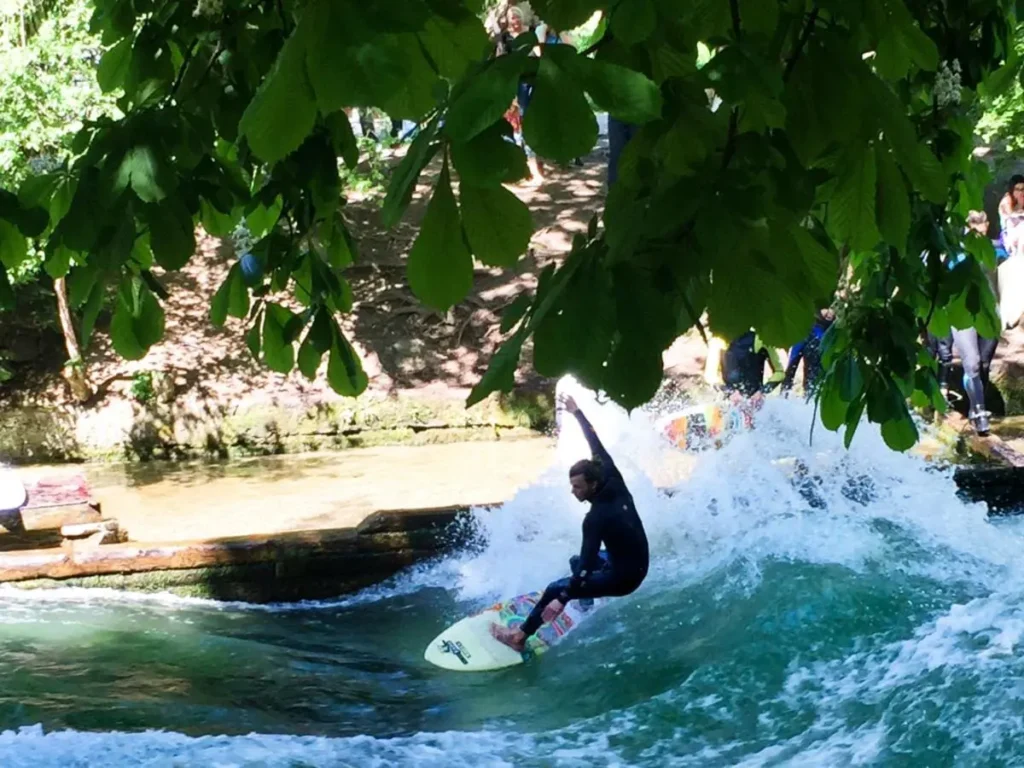

Courtyard garden
Court and financial garden of the sovereigns of the Free State of Bavaria. Both gardens were laid out in the rectangular French style at the behest of the dukes and later kings from the 17th century onwards. They are located near the former Munich Residence, the largest city palace in Germany. It is open to visitors from April to October from 9 am to 6 pm (last admission: 5 pm). The architecture, room decorations and exhibits from the former royal collections are particularly worth seeing. Next door is the State Chancellery (completed in 1993), where the Bavarian head of government conducts his official business. It was built around the central dome of the former Bavarian Army Museum. In front of the west side of the courtyard is a war memorial commemorating the victims of the two world wars and the equestrian statue of Duke Otto I from the long-reigning Wittelsbach dynasty (1180-1918).
House of Art
In nearby Prinzregentenstraße, you can visit the Haus der Kunst, an established exhibition center for contemporary art. The monumental building was erected in the 1930s as a highly visible Nazi structure and is a constant point of contention as to its appropriate use today. For night owls, it also houses Club P 1. Before the 1972 Summer Olympics in Munich, a Japanese teahouse with a garden was set up on a small island nearby. During the summer, public tea ceremonies are held there on some weekends.
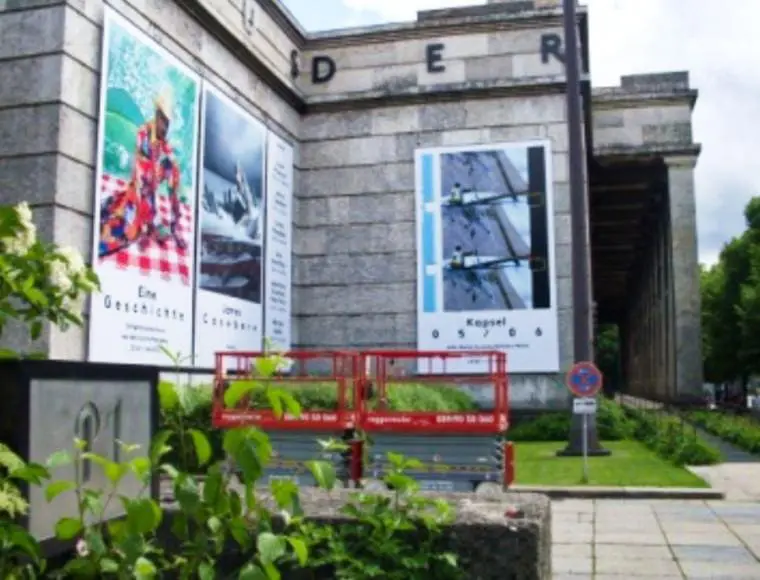

Eisbach
The waterfall (10) was created in 1814 and 1815 as a natural-looking cascade within the Eisbach stream. Master builder Sckell was probably inspired by Dutch landscape paintings. The famous Eisbach surfers, who have been practicing on the artificial wave all year round since the early 1970s, can be found right at the transition to the city behind the Haus der Kunst. For a few years now, more and more women have also been showing off their skills there. However, there is a high risk of injury, which is why amateurs and non-locals are advised not to actively participate. There is also a second wave of a lower grade (12) along the stream. In general, visitors to the park are urged to avoid water sports of any kind. Some ignore the ban, but they also attract many fascinated glances.
Monopteros
The Monopteros (20) is a small temple built in the Greek style. It was renovated and given a new color scheme in autumn 2016. The square is a popular meeting place and offers a wonderful view of the park and city. However, direct access by bike is not possible, please park and lock it and walk the short distance. In the middle of the southern, heavily frequented part of the park is the famous Chinese Tower with its large beer garden (24). With almost 7,000 seats, the beer garden is the second largest in Munich. The pagoda was destroyed during the Second World War and then rebuilt. The surrounding grounds were once intended as a model agricultural site, but today they are home to the English Garden administration. And the wide meadows all around – e.g. the Werneckwiese (29) – are used for sport and recreation.
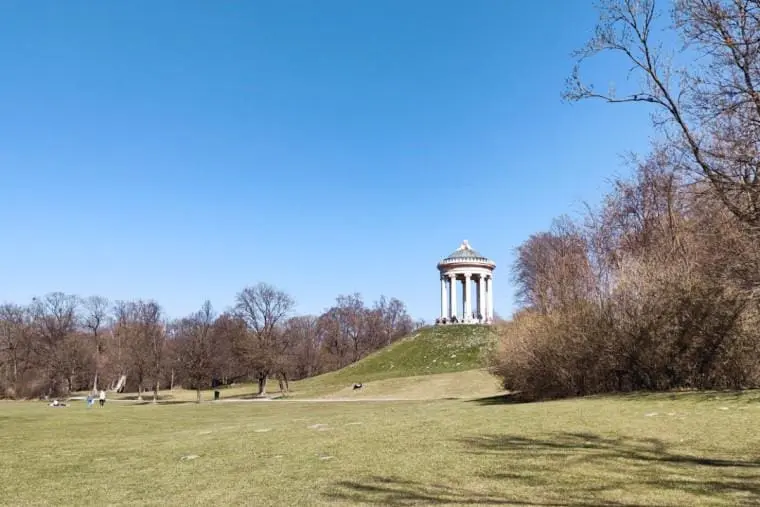
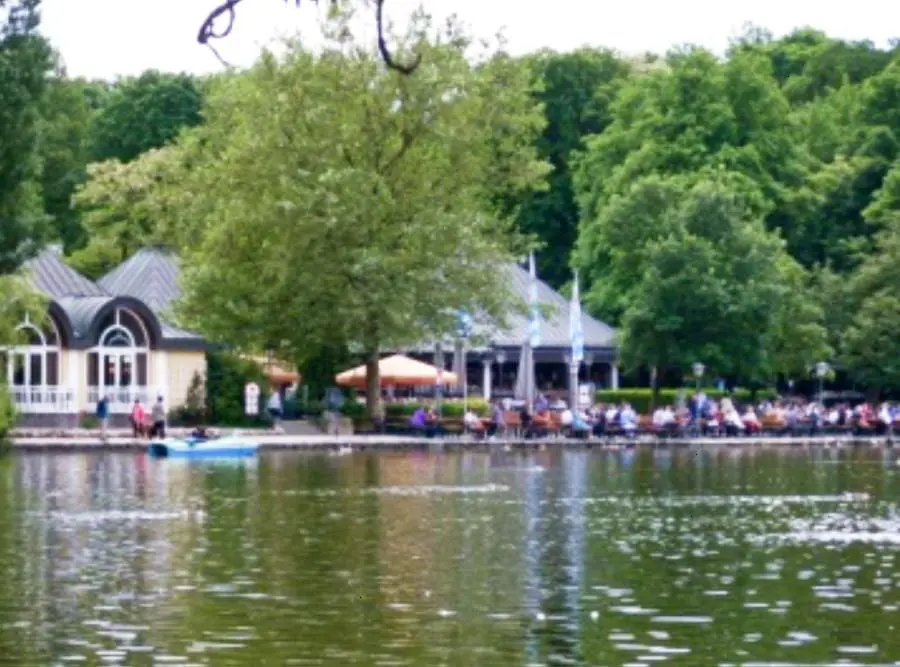
Lake house
At the man-made Kleinhesseloher See (31) there is the Seehaus beer garden (34), where you can relax right by the water, and a boat rental (35). However, you are not allowed to enter the small islands in the middle of the lake because of the breeding grounds. Here you can also cross the Isarring (38) and reach the quiet and truly natural northern part of the park. There is a pedestrian bridge and an underpass near the Seehaus.
Northern part of the English Garden
The northern part of the park used to be known as “Hirschau” because it served as an extensive hunting ground. There are also a number of sights here, such as a dam over which the Isar can be crossed and a small amphitheater that is used for open-air performances in summer. You can also see the remains of the former “J. A. Maffei” locomotive factory. Some farming is also still carried out here. In this part of the English Garden, you can really ride your e-bikes unhindered and soak up the natural ambience of the park. Other beer gardens worth visiting include Hirschau (49), St. Emmeramsmühle (61) and Aumeister (70).
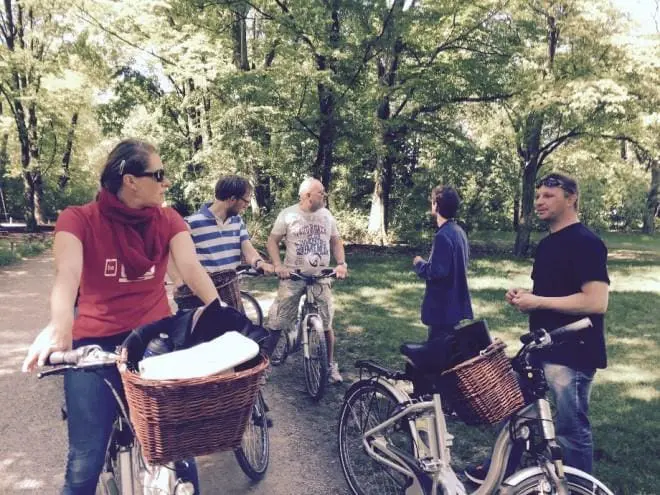

Amphitheater
The amphitheater in the English Garden has existed at various locations in the park since 1793. The open-air stage is currently located on the so-called Siebenbuchenwiese (64), which has been used every summer since 1985. The “Münchner Sommertheater” team stages changing performances there in the middle of the slightly sloping meadow, attracting culture and picnic fans alike. The exact program can be found under the following link.
Oberföhring weir
Here (59) the Isar is dammed 6.60 meters high and the water is diverted into the Middle Isar Canal. The weir itself is not a hydroelectric power station. However, there is a small, largely underground power station directly below the weir, through which water from the canal is fed back into the Isar. The associated building is the small one behind the fish ladder. It produces 5.7 million kilowatt hours per year. The weir spans a total of 78.50 meters with four arches, each 17 meters wide and around 5.70 meters high. The supporting pillars offer a beautiful vantage point. Up to 150 cubic meters of water can be diverted per second.
The water discharged here powers E.ON’s Oberföhring hydropower plant. In 2008, E.ON undertook to leave sufficient water in the Isar, as the water level kept dropping. This is why the small power plant was built, which is fed with water and was connected to the grid in 2008. The water discharged here flows back into the Isar after 64 km (just before Landshut).


Tivoli power station
This is a listed hydroelectric power station on the Eisbach. It is located in the northern part of the Englischer Garten near Gyßlingstraße (52). Built in 1895/96, the power station supplied electricity for the J.A. Maffei locomotive factory in nearby Hirschau from 1896 to 1931. In the meantime, it was shut down. In the summer of 1986, the power station was put back into operation after modernization and renovation.
Former Maffei plant
The J.A. Maffei locomotive factory (now known as the Maffei factory for short) stood on an area of 310,000 square meters (51) from 1838 to 1931. At the time, Maffei was one of the largest heavy industry producers and had several thousand employees. The site had several factory buildings and was criss-crossed by canals and pipelines. Around the turn of the century, a railway siding was also added. The visual impression here was more reminiscent of the Ruhr area. In 1931, Maffei filed for bankruptcy and the company founded by former employee Georg Krauß took over the business and moved to Munich-Allach. During the Second World War, the Wehrmacht set up warehouses and magazines on the site. Afterwards, makeshift factory barracks were built. Today, only the Maffei power station in the English Garden is a reminder of the former factory.

Excerpt from: MucBike English Garden Tour
copyright by MucTours
